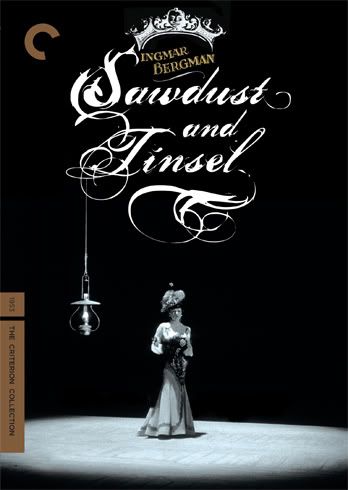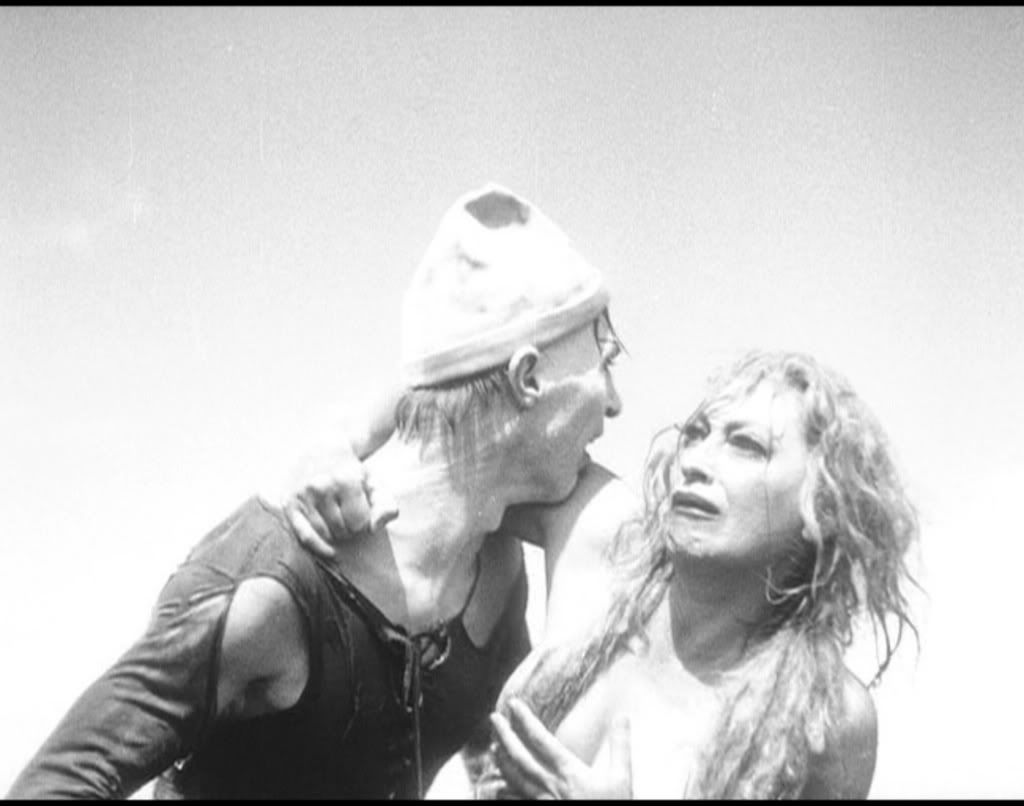By Dan Callahan Ingmar Bergman made eleven films before his breakthrough, Summer with Monika (1952), where he seemed to be stimulated by filming his lover at the time, Harriet Andersson, a bluntly carnal brunette. Andersson is also crucial to his next film, Sawdust and Tinsel (1953), marketed in the US as The Naked Night. There’s no real nudity in the movie, though Andersson’s breasts often threaten to burst out of her period clothing and, as always, her big, wet, striated lips are so central to the images that they should have their own special billing. In the famous flashback that comes at the beginning of the film, Alma (Gudrun Brost), a coarse, aging blond desperately trying to prove that she’s still attractive, cavorts nude in the sea with a regiment of soldiers. Her clown husband (Anders Ek) pulls her out of the water, covering her nakedness with his body. But there’s no covering the nakedness of his emotions under his heavy clown make-up, and no possible way to cover up his wife’s disgrace.
Ingmar Bergman made eleven films before his breakthrough, Summer with Monika (1952), where he seemed to be stimulated by filming his lover at the time, Harriet Andersson, a bluntly carnal brunette. Andersson is also crucial to his next film, Sawdust and Tinsel (1953), marketed in the US as The Naked Night. There’s no real nudity in the movie, though Andersson’s breasts often threaten to burst out of her period clothing and, as always, her big, wet, striated lips are so central to the images that they should have their own special billing. In the famous flashback that comes at the beginning of the film, Alma (Gudrun Brost), a coarse, aging blond desperately trying to prove that she’s still attractive, cavorts nude in the sea with a regiment of soldiers. Her clown husband (Anders Ek) pulls her out of the water, covering her nakedness with his body. But there’s no covering the nakedness of his emotions under his heavy clown make-up, and no possible way to cover up his wife’s disgrace. Sawdust and Tinsel is Bergman’s first film where the idea of humiliation, specifically sexual humiliation, becomes crucial to his conception. It was a theme that obsessed him throughout his career, and it has no more painful expression than in this flashback of the clown and his big Fellini-esque wife, which is shot in a deliberately over-exposed way, as if harsh light was pounding down on everyone and everything. This flashback evokes Murnau, Eisenstein and even Welles; at bottom, it is an homage and an intensification of a German silent film like E.A. Dupont’s Variety (1925), with its strobe-like effects. You can feel Bergman finally realizing the full possibility of what a camera can do and, even more importantly, what sound and its absence can convey. We don’t hear any words when the people talk or shout on the beach, only the soldier’s derisive laughter on the track, and unsettlingly hollow, phallic canon bursts at irregular intervals. Looking at this scene and the best scenes in Sawdust and Tinsel is a little like listening to the modernist music of Stravinsky, or Alban Berg (the score by Karl-Birger Blomdahl is aggressively modernist and tense). Bergman’s new, bursting talent for Expressionist editing and composition helps distract us from the fact that the basic situation between the clown and his wife is more than a little bit corny.
Sawdust and Tinsel is Bergman’s first film where the idea of humiliation, specifically sexual humiliation, becomes crucial to his conception. It was a theme that obsessed him throughout his career, and it has no more painful expression than in this flashback of the clown and his big Fellini-esque wife, which is shot in a deliberately over-exposed way, as if harsh light was pounding down on everyone and everything. This flashback evokes Murnau, Eisenstein and even Welles; at bottom, it is an homage and an intensification of a German silent film like E.A. Dupont’s Variety (1925), with its strobe-like effects. You can feel Bergman finally realizing the full possibility of what a camera can do and, even more importantly, what sound and its absence can convey. We don’t hear any words when the people talk or shout on the beach, only the soldier’s derisive laughter on the track, and unsettlingly hollow, phallic canon bursts at irregular intervals. Looking at this scene and the best scenes in Sawdust and Tinsel is a little like listening to the modernist music of Stravinsky, or Alban Berg (the score by Karl-Birger Blomdahl is aggressively modernist and tense). Bergman’s new, bursting talent for Expressionist editing and composition helps distract us from the fact that the basic situation between the clown and his wife is more than a little bit corny. Bergman is not always successful in masking the trite aspects of his screenplay when the story proper kicks in, as we watch the bull-like circus owner Albert (Åke Grönberg) laid low in tried and true Emil Jannings fashion by Andersson’s petulant, teasing mistress. Andersson walks down a street like she just loves being good-looking and looked at; very rarely has a film actress been so brazen about her own beauty. Bergman attempts to take her down a notch in her dealings with an aging, pretty boy actor (Hasse Ekman), but not before she makes him get on his knees and bang his head on the floor at her feet. Later, they have an arm-wrestling contest that he just barely wins; there is some black humor in this literal battle of the sexes. Bergman once called the theater his faithful wife, while the cinema was his “costly, exacting mistress.” When we watch him watch his mistress Andersson, we can only be glad that he paid the price for such pleasure, cinematically speaking.
Bergman is not always successful in masking the trite aspects of his screenplay when the story proper kicks in, as we watch the bull-like circus owner Albert (Åke Grönberg) laid low in tried and true Emil Jannings fashion by Andersson’s petulant, teasing mistress. Andersson walks down a street like she just loves being good-looking and looked at; very rarely has a film actress been so brazen about her own beauty. Bergman attempts to take her down a notch in her dealings with an aging, pretty boy actor (Hasse Ekman), but not before she makes him get on his knees and bang his head on the floor at her feet. Later, they have an arm-wrestling contest that he just barely wins; there is some black humor in this literal battle of the sexes. Bergman once called the theater his faithful wife, while the cinema was his “costly, exacting mistress.” When we watch him watch his mistress Andersson, we can only be glad that he paid the price for such pleasure, cinematically speaking. Harriet Andersson has always been an odd woman out in the Ingmar Bergman gallery of females; she’s clearly a little slutty, a little low-class, and in Sawdust he has her mock the “pale, flat-chested actresses” that Ekman’s actor (and Bergman himself) is used to working with. As is his wont, Bergman drops a heavy dollop of Strindberg into this bit of sexual autobiography. The actor debases Andersson as she has debased him (Ekman holds her down on the floor at one point: as she struggles, never has the unshaved hair under a woman’s arms looked more enticing). With his lined, sneering face, Ekman personifies one of Bergman’s keener insights: the emotional vampirism of actors. But Bergman abandons Ekman and his sadomasochistic contest with Andersson and throws the whole ending to Grönberg’s circus owner. It’s difficult to feel much of anything for this standard, Germanic brute, even when Ekman is kicking dust in his face in front of an excited audience. The ending is heavily symbolic and a bit pompous, with the clown longingly explicating a dream he had about curling up in his wife’s womb, but Sawdust and Tinsel is still a key early Bergman film that anticipates his major works of the sixties.
Harriet Andersson has always been an odd woman out in the Ingmar Bergman gallery of females; she’s clearly a little slutty, a little low-class, and in Sawdust he has her mock the “pale, flat-chested actresses” that Ekman’s actor (and Bergman himself) is used to working with. As is his wont, Bergman drops a heavy dollop of Strindberg into this bit of sexual autobiography. The actor debases Andersson as she has debased him (Ekman holds her down on the floor at one point: as she struggles, never has the unshaved hair under a woman’s arms looked more enticing). With his lined, sneering face, Ekman personifies one of Bergman’s keener insights: the emotional vampirism of actors. But Bergman abandons Ekman and his sadomasochistic contest with Andersson and throws the whole ending to Grönberg’s circus owner. It’s difficult to feel much of anything for this standard, Germanic brute, even when Ekman is kicking dust in his face in front of an excited audience. The ending is heavily symbolic and a bit pompous, with the clown longingly explicating a dream he had about curling up in his wife’s womb, but Sawdust and Tinsel is still a key early Bergman film that anticipates his major works of the sixties.
Image/Sound/Extras: Aside from two brief vertical lines, the 1.33:1 pictureboxed image is spotless, doing very well by the tricky overexposure in the nightmare flashback, and the mono sound is bracing. There’s a brief intro by Bergman where he speaks of his affection for this film, saying that he likes its “wildness,” and a solid audio commentary by Bergman biographer Peter Cowie, who reports Andersson’s latter-day tales of Bergman’s intense bouts of jealousy during the shoot. “I was bloody faithful!” Andersson insists. Maybe she was.
_________________________________________________
House contributor Dan Callahan's writing has appeared in Slant Magazine, Bright Lights Film Journal and Senses of Cinema, among other publications.
Tuesday, May 1, 2007
The Criterion Collection #412: Sawdust and Tinsel
Labels:
Dan Callahan,
Ingmar Bergman,
Sawdust and Tinsel
Subscribe to:
Post Comments (Atom)
No comments:
Post a Comment